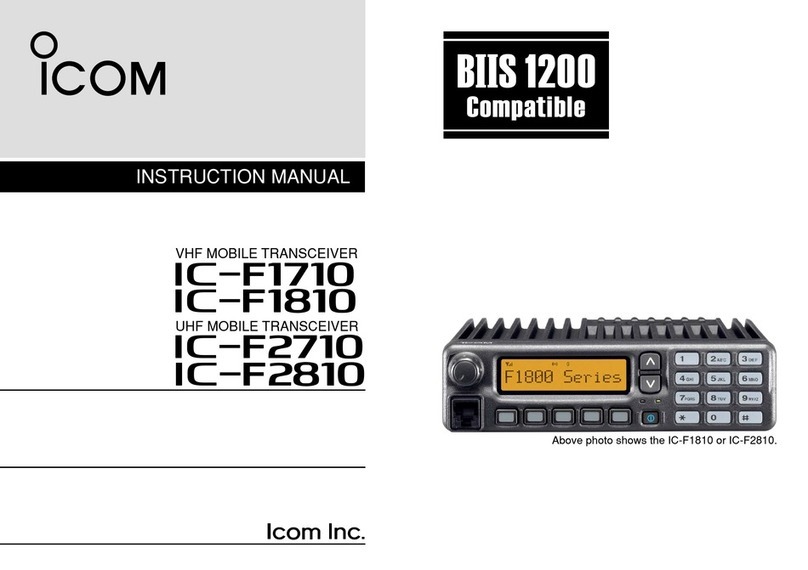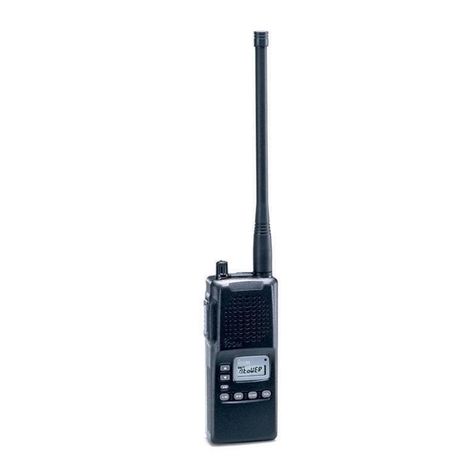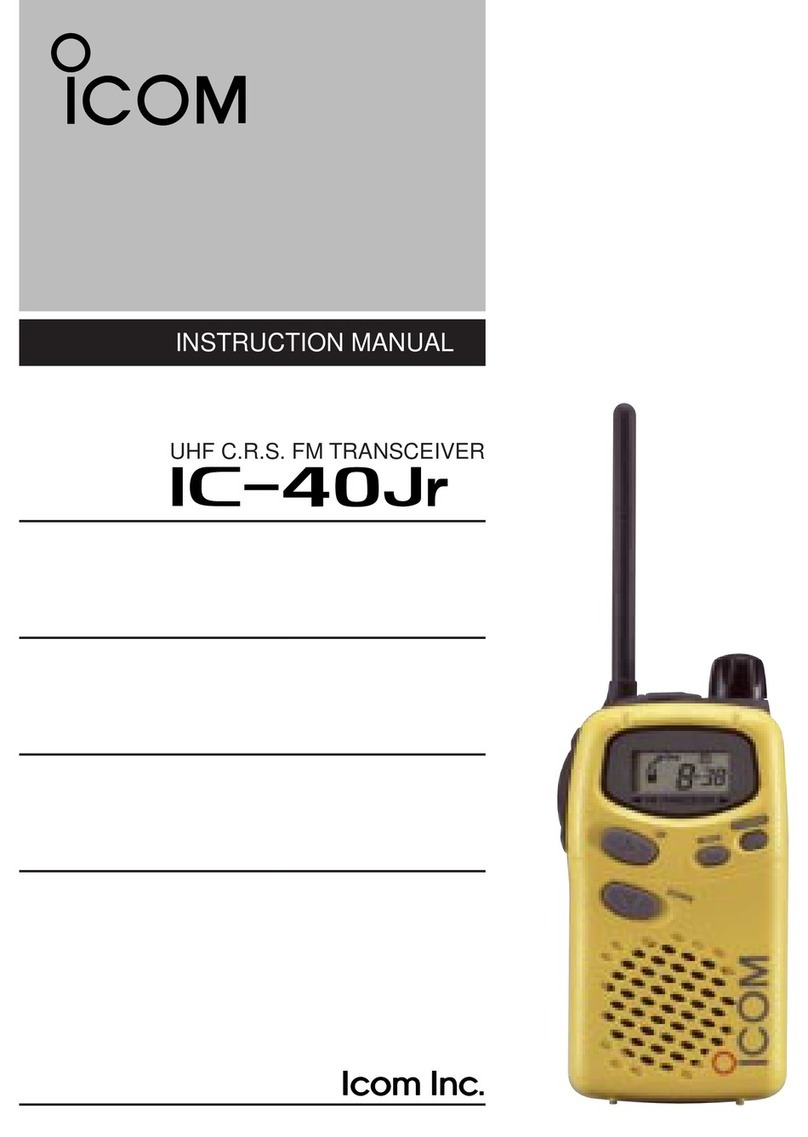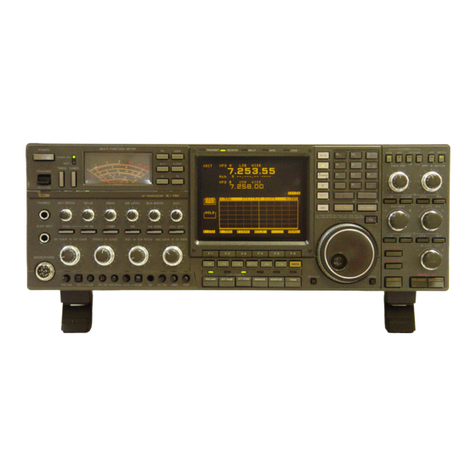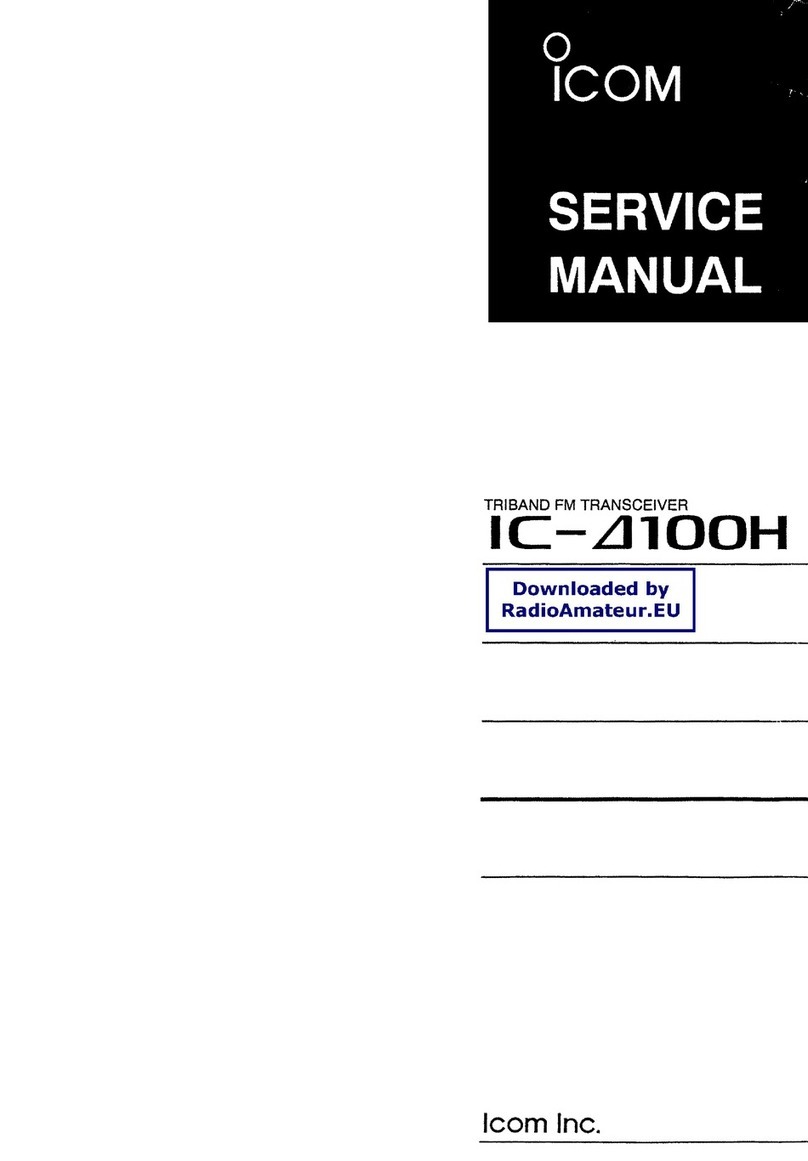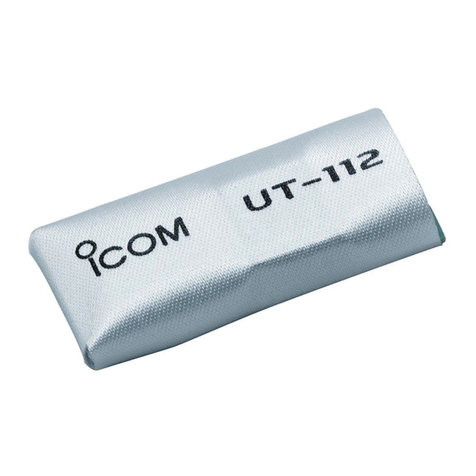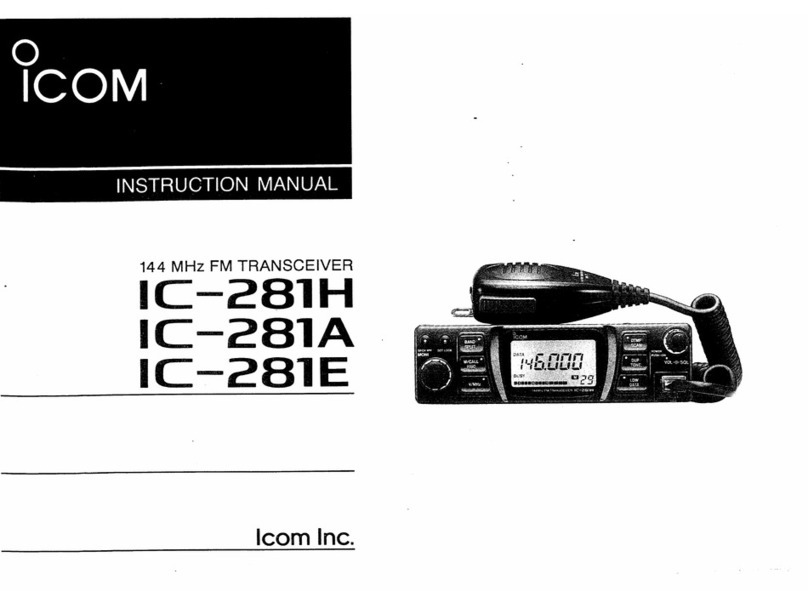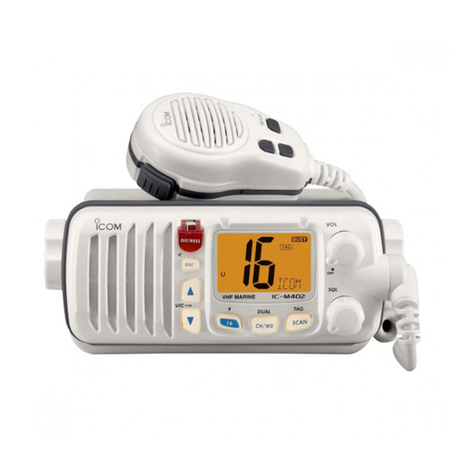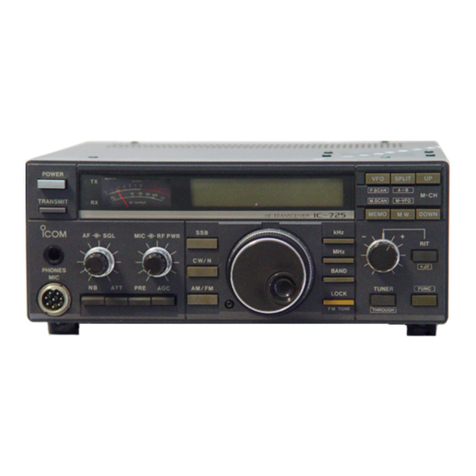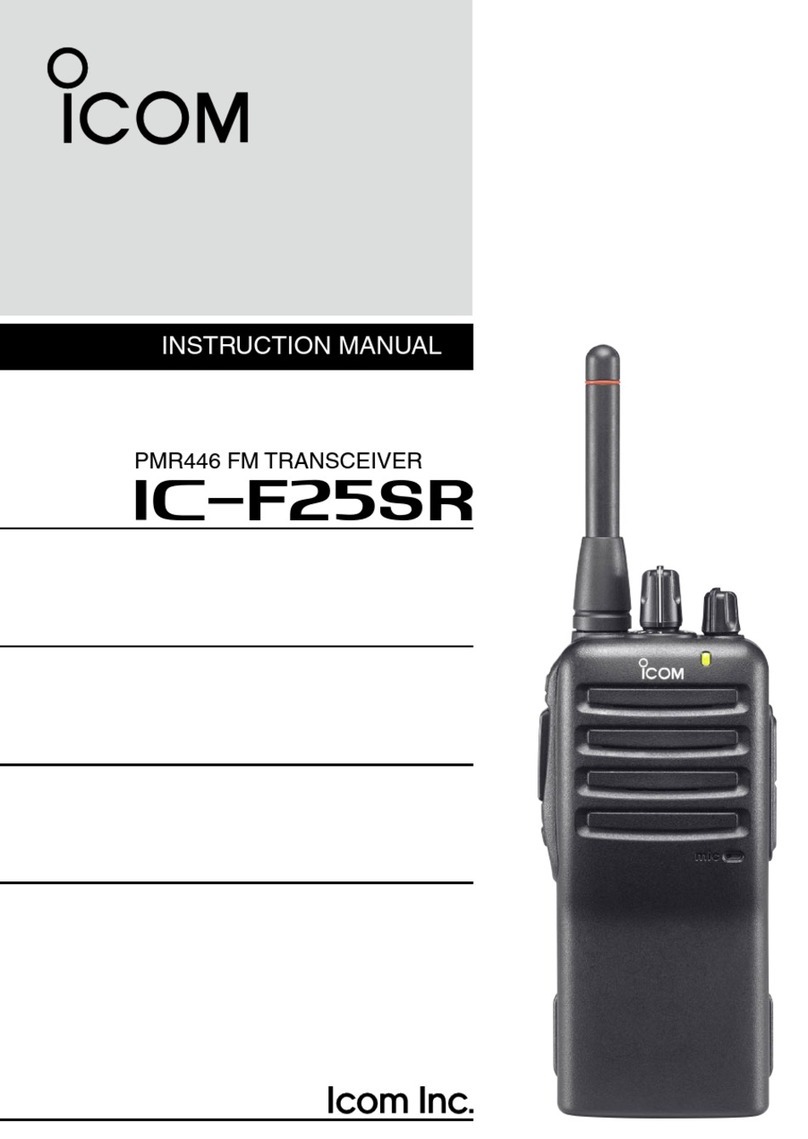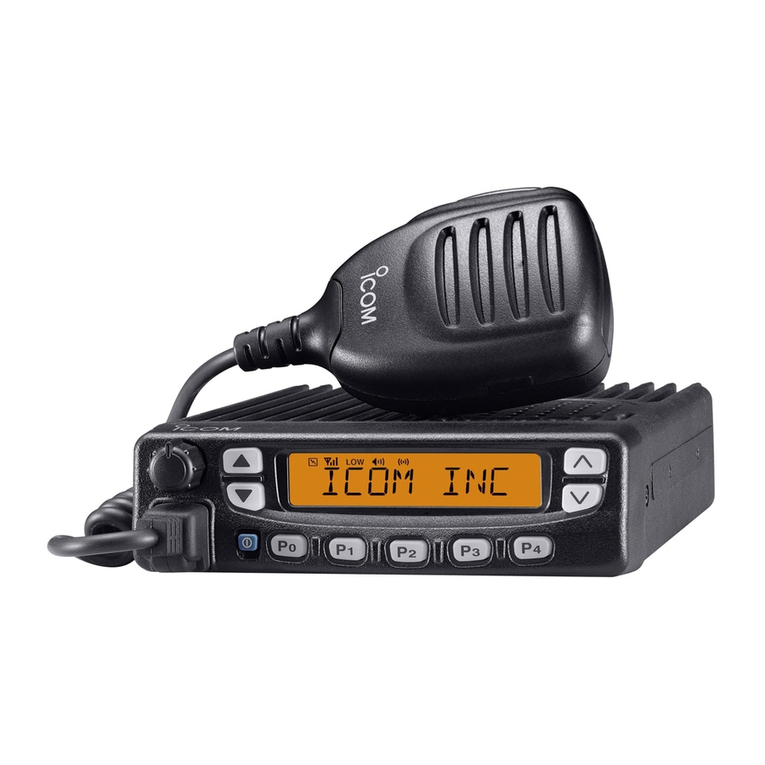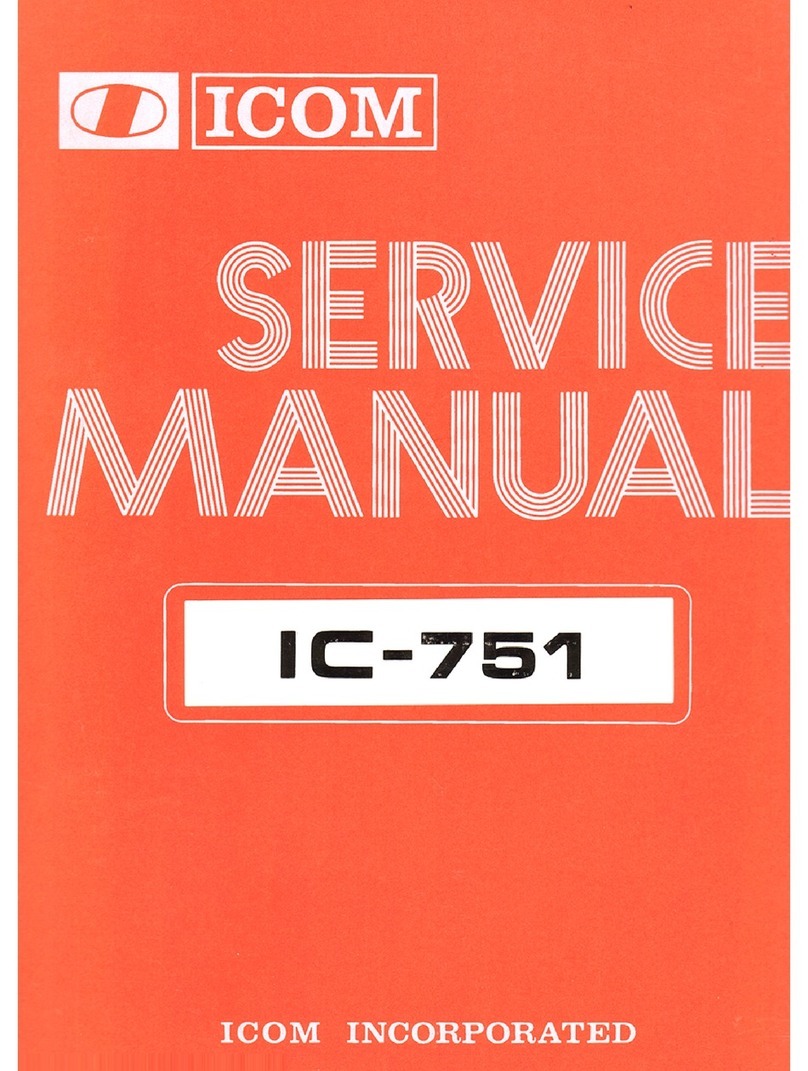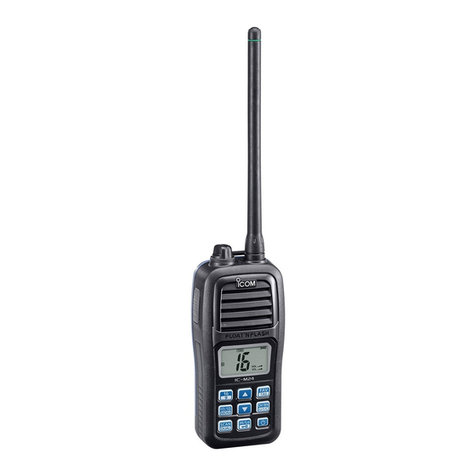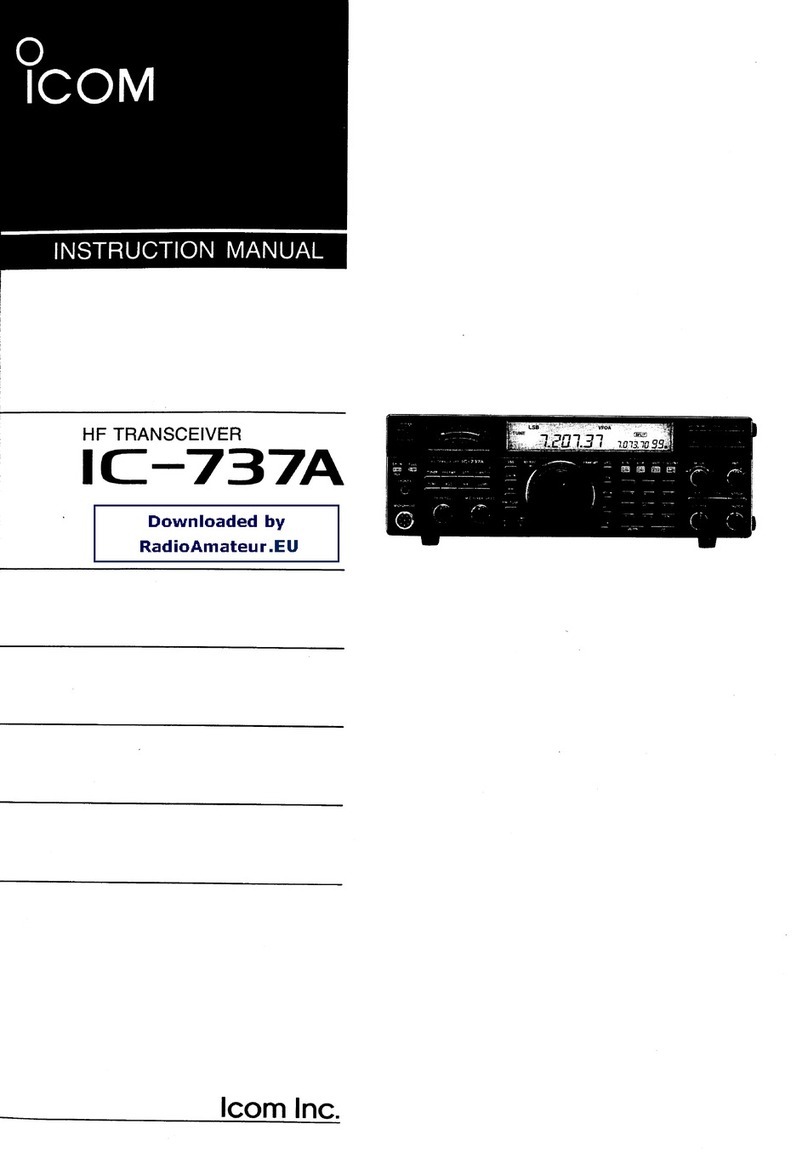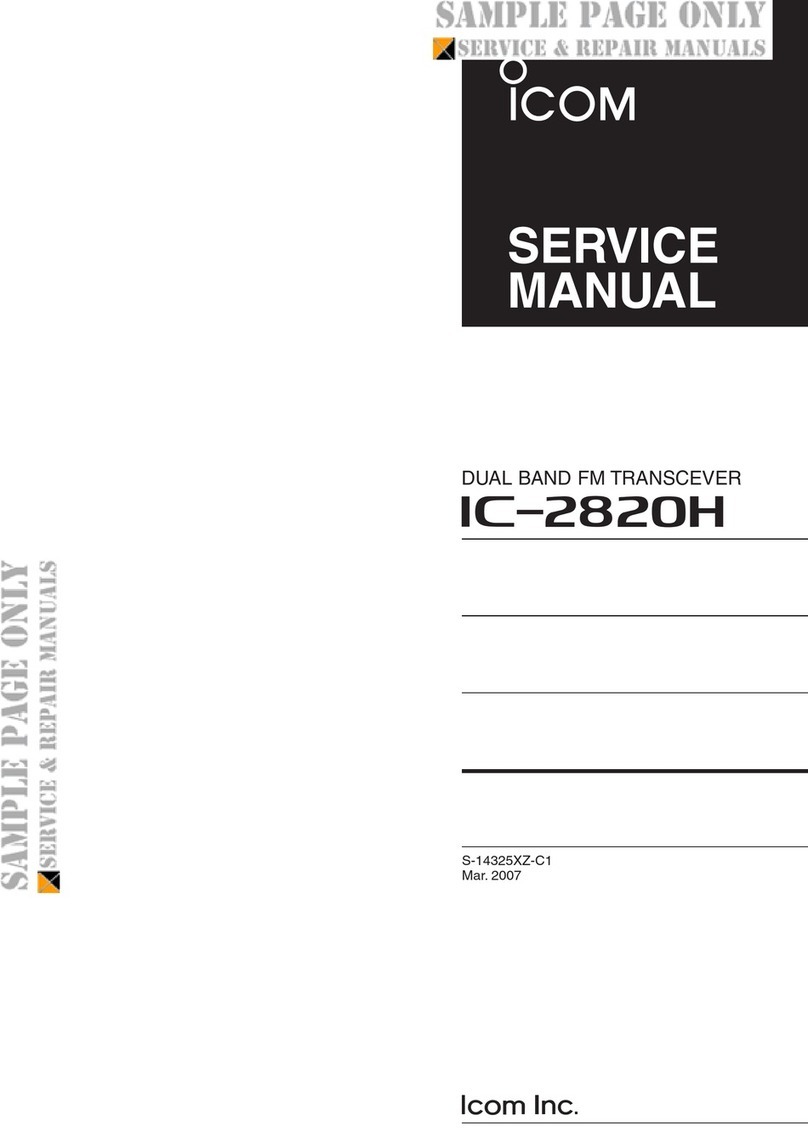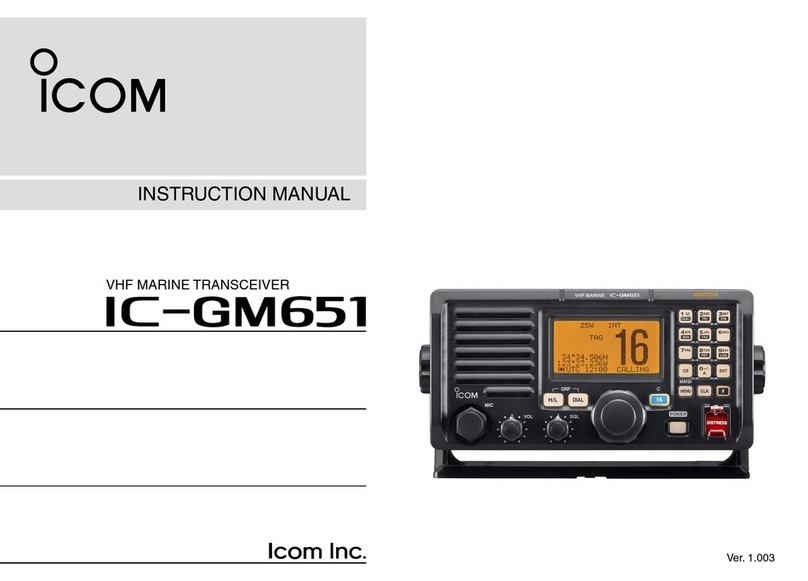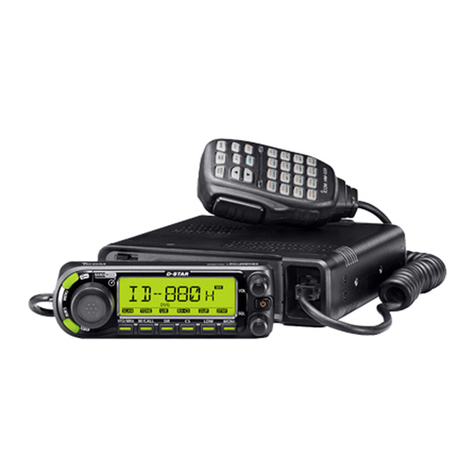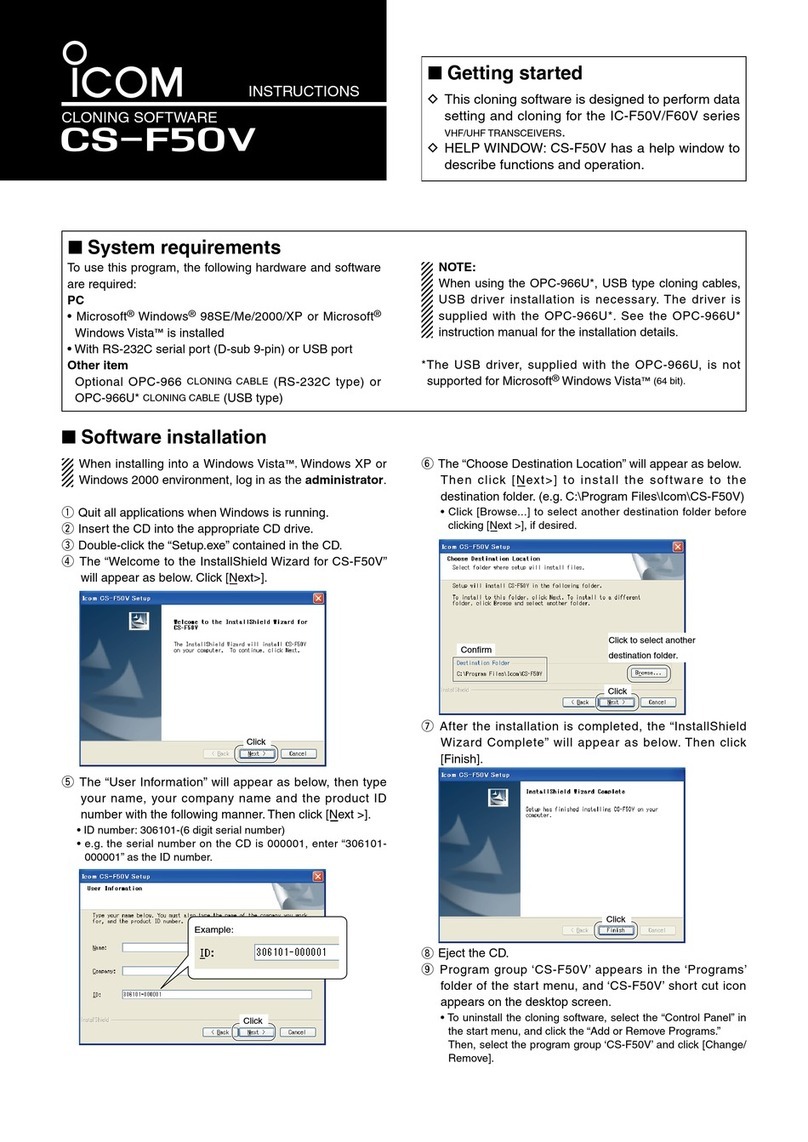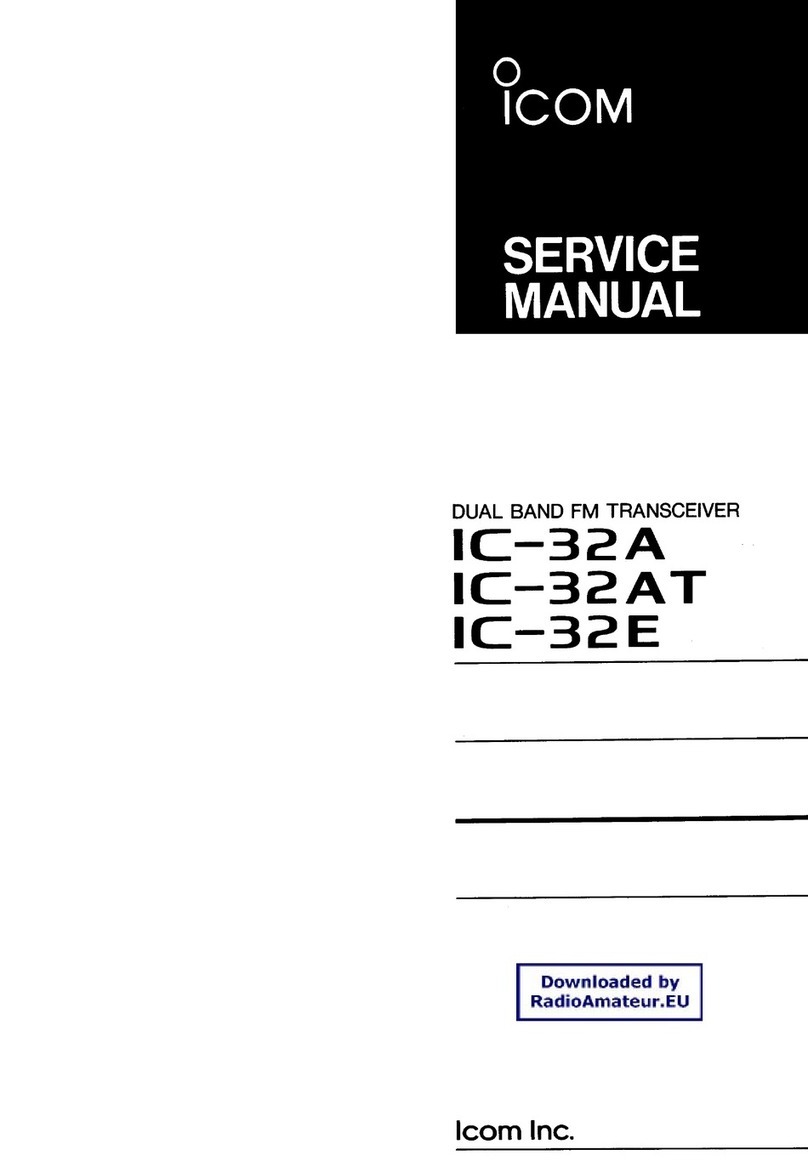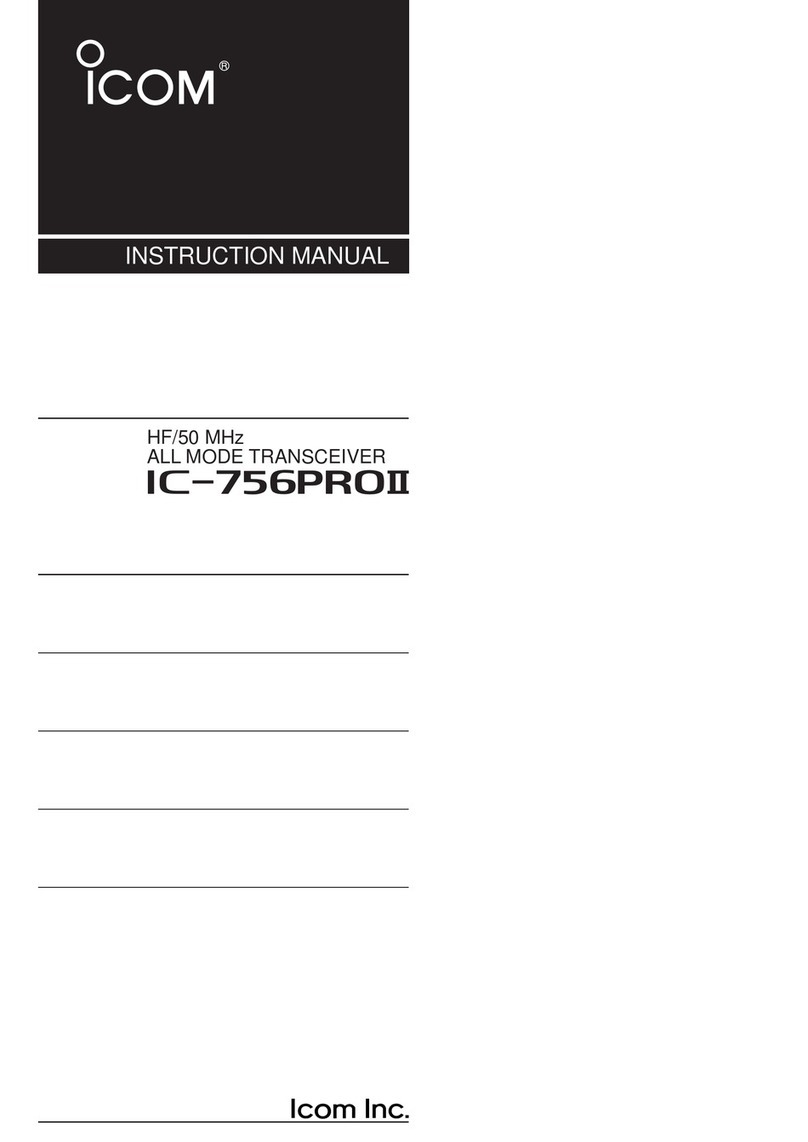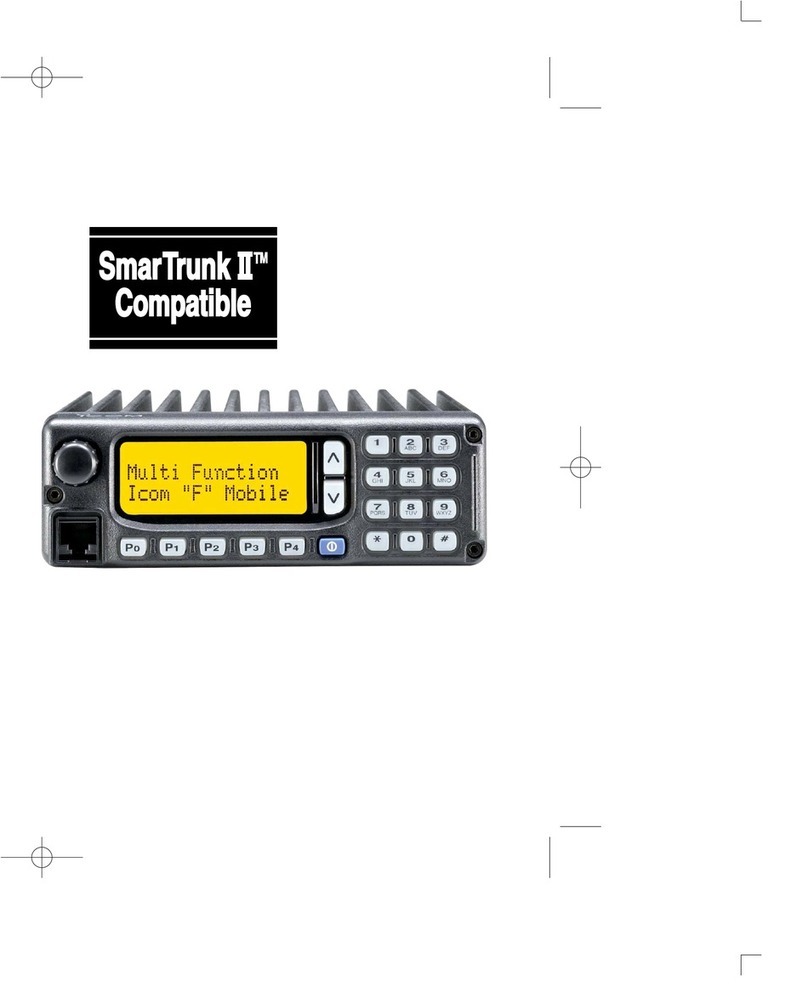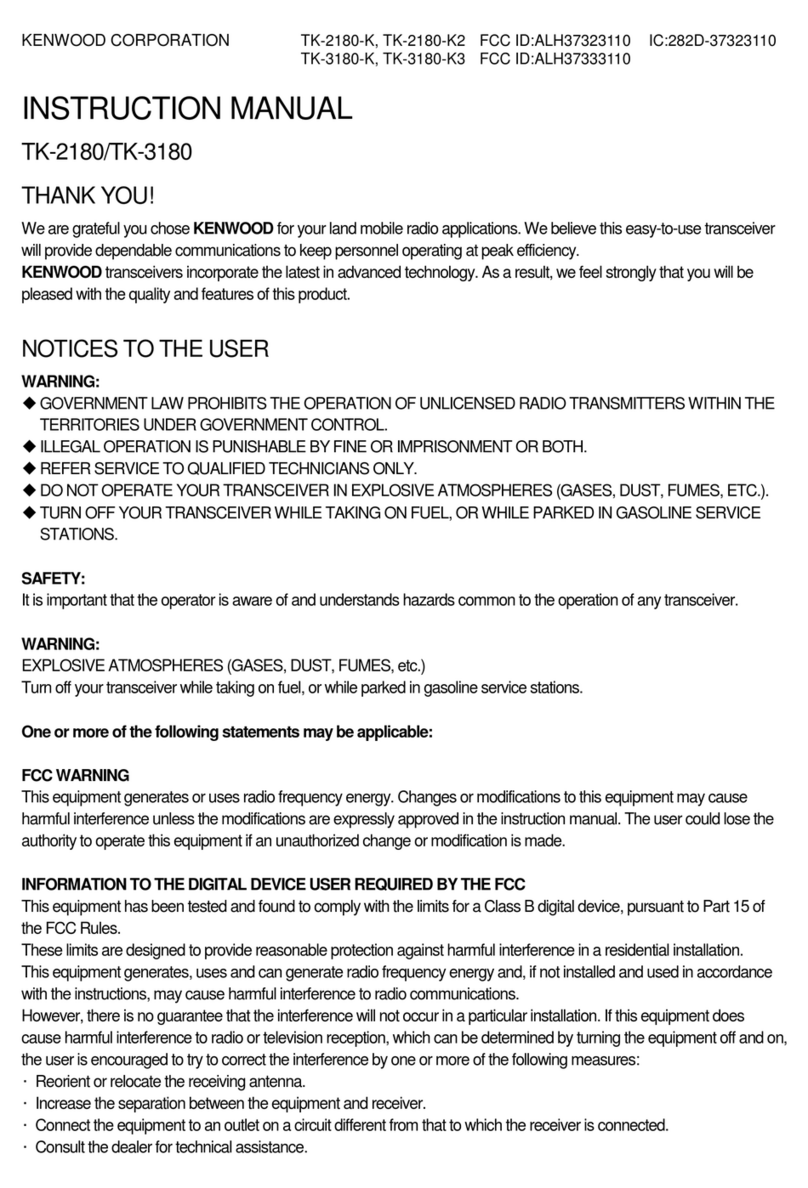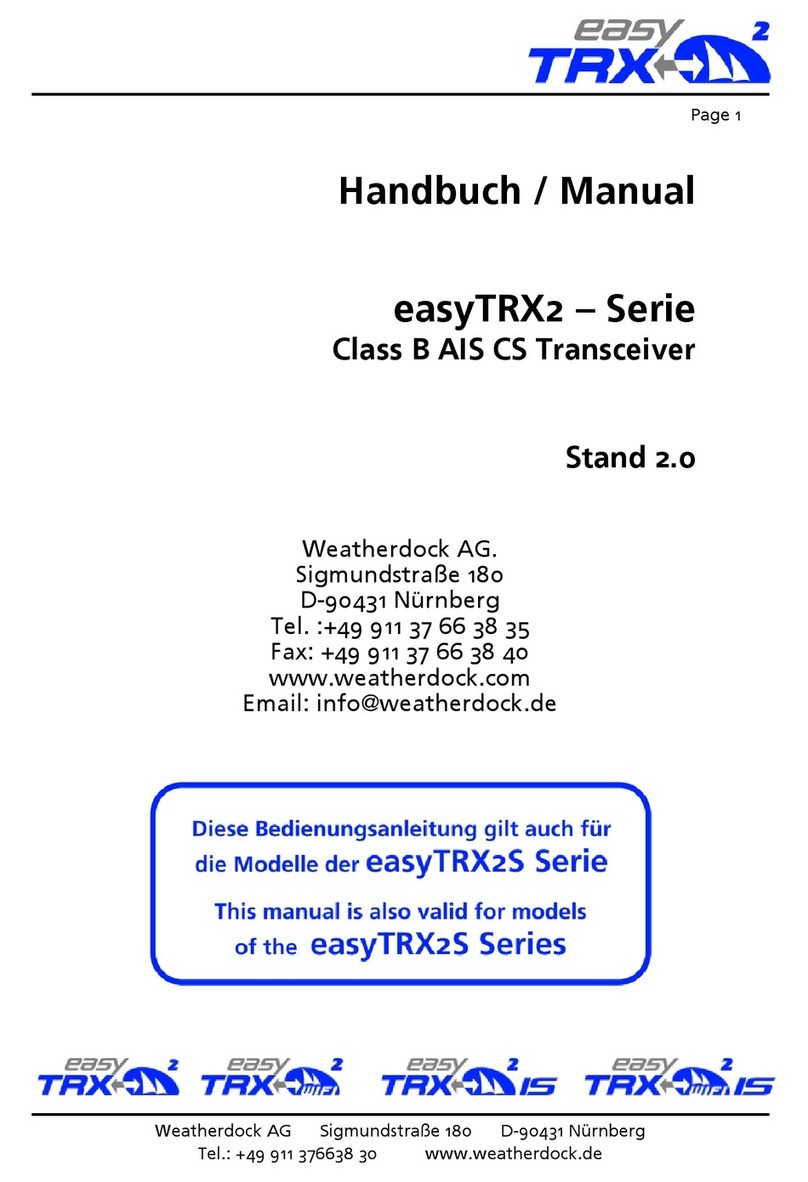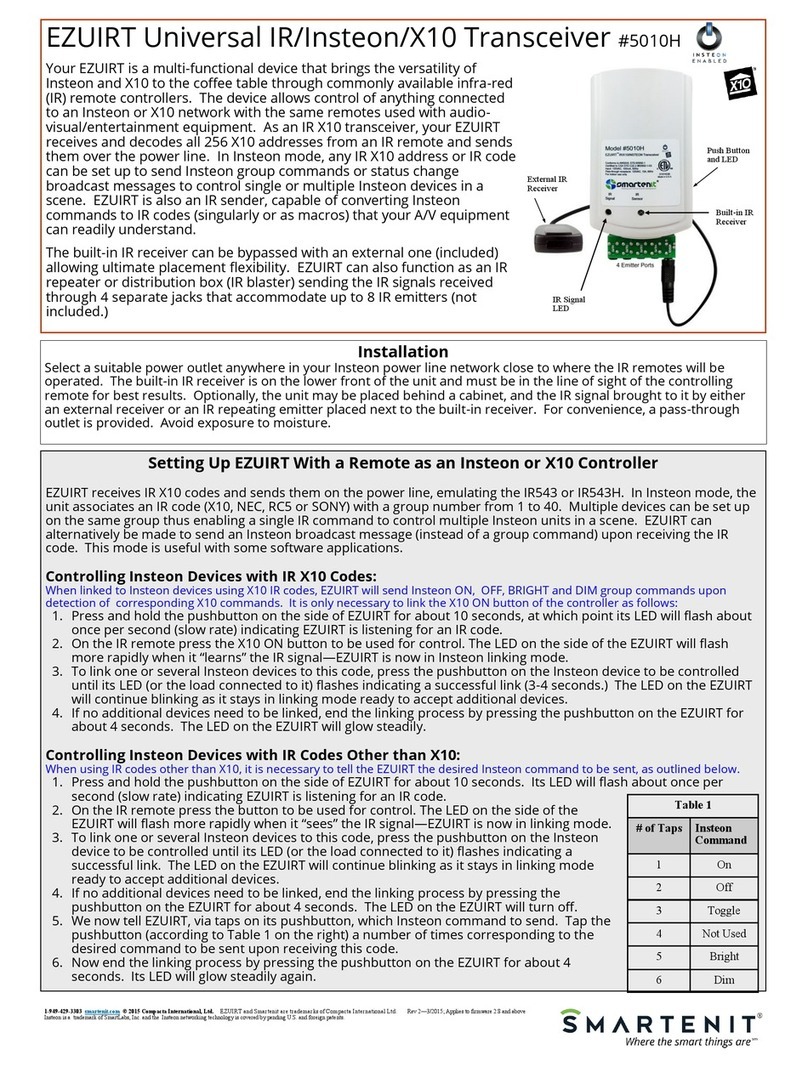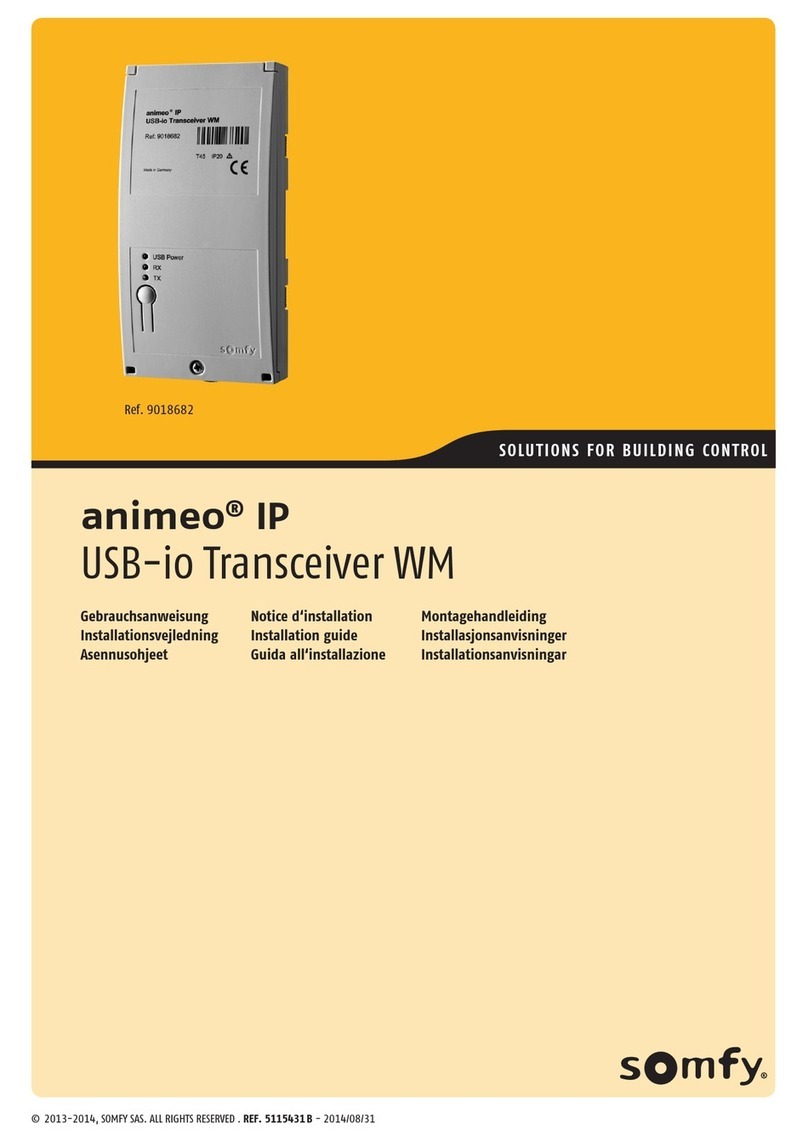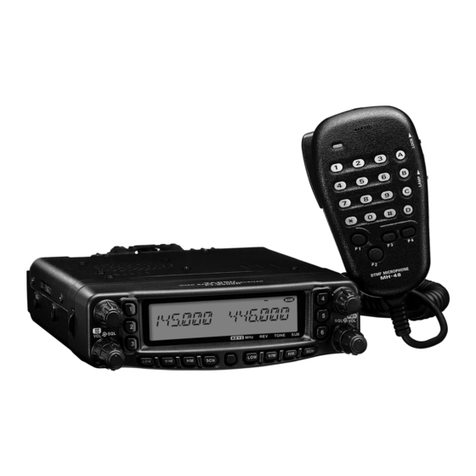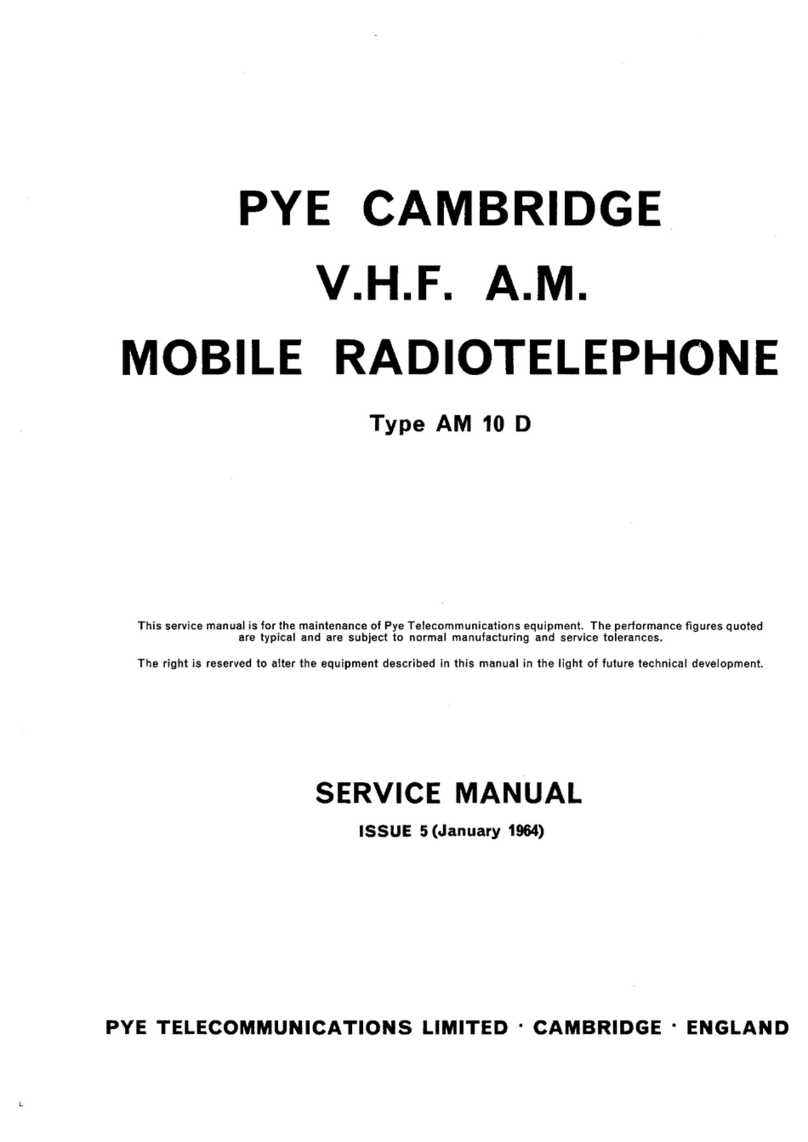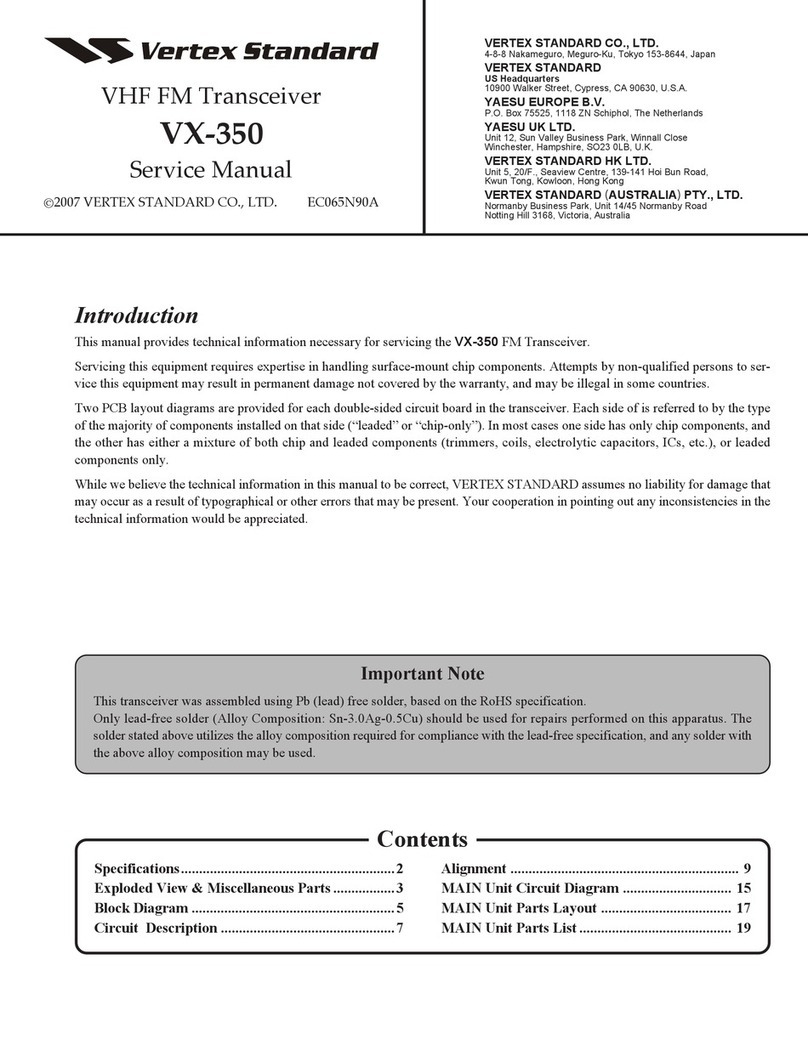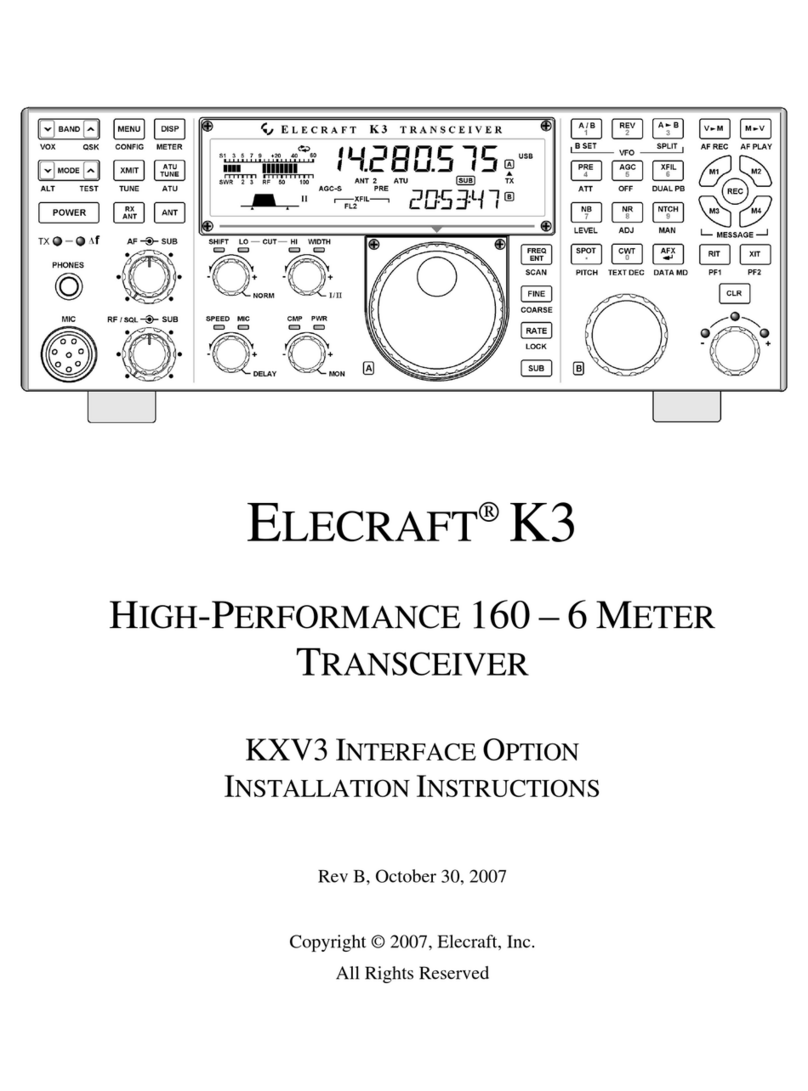Icom IC-F5020 Series User manual

INSTRUCTION MANUAL
VHF MOBILE TRANSCEIVERS
iF5020
Series
UHF MOBILE TRANSCEIVERS
iF6020
Series

i
Icom, Icom Inc. and the Icom logo are registered trademarks of Icom
Incorporated (Japan) in Japan, the United States, the United Kingdom,
Germany, France, Spain, Russia, Australia, New Zealand, and/or other
countries.
All other products or brands are registered trademarks or trademarks of their
respective holders.
Thank you for choosing this Icom product. This product is
designed and built with Icom’s state of the art technology
and craftsmanship. With proper care this product should
provide you with years of trouble-free operation.
IMPORTANT
READ ALL INSTRUCTIONS carefully and completely
before using the transceiver.
SAVE THIS INSTRUCTION MANUAL — This
instruction manual contains important operating instructions
for the IC-F5021, IC-F5023, IC-F5023H, IC-F5026, IC-
F5026H, IC-F5028H vhf mobile transceivers and the
IC-F6021, IC-F6023, IC-F6023H, IC-F6028H uhf mobile
transceivers.
EXPLICIT DEFINITIONS
WORD DEFINITION
RWARNING! Personal injury, fire hazard or electric
shock may occur.
CAUTION Equipment damage may occur.
NOTE
If disregarded, inconvenience only. No risk
of personal injury, fire or electric shock.
FCC INFORMATION
• FOR CLASS A UNINTENTIONAL RADIATORS:
This equipment has been tested and found to comply with
the limits for a Class A digital device, pursuant to part 15
of the FCC Rules. These limits are designed to provide
reasonable protection against harmful interference when the
equipment is operated in a commercial environment. This
equipment generates, uses, and can radiate radio frequency
energy and, if not installed and used in accordance with the
instruction manual, may cause harmful interference to radio
communications.
Operation of this equipment in a residential area is likely to
cause harmful interference in which case the user will be
required to correct the interference at his own expense.
CAUTION: Changes or modifications to this transceiver, not
expressly approved by Icom Inc., could void your authority to
operate this transceiver under FCC regulations.

ii
PRECAUTIONS
RWARNING! NEVER operate the transceiver during
a lightning storm. It may result in an electric shock, cause a
fire or damage the transceiver. Always disconnect the power
souce and antenna before a storm.
RWARNING! NEVER connect the transceiver to an AC
outlet. This may pose a fire hazard or result in an electric shock.
RWARNING! NEVER connect the transceiver to a
power source of more than 16 V DC or use reverse polarity.
This could cause a fire or damage the transceiver.
RWARNING! NEVER cut the DC power cable
between the DC plug and fuse holder. If an incorrect
connection is made after cutting, the transceiver might be
damaged.
RWARNING! NEVER place the transceiver where
normal operation of the vehicle may be hindered or where it
could cause bodily injury.
CAUTION: NEVER allow children to touch the
transceiver.
CAUTION: NEVER expose the transceiver to rain,
snow or any liquids.
DO NOT
operate or place the transceiver in areas with
temperatures below –30°C (–22°F) or above +60°C (+140°F),
or in areas subject to direct sunlight, such as the dashboard.
DO NOT
operate the transceiver without running the
vehicle’s engine. The vehicle’s battery will quickly run out when
the transceiver transmits while the vehicle’s engine is OFF.
DO NOT place the transceiver in excessively dusty
environments.
DO NOT place the transceiver against walls. This will
obstruct heat dissipation.
DO NOT use harsh solvents such as benzine or alcohol
when cleaning, as they will damage the transceiver surfaces.
BE CAREFUL! The transceiver will become hot when
operating continuously for long periods.
USE the specified microphone only. Other microphones
have different pin assignments and may damage the
transceiver.
Icom is not responsible for the destruction or damage to
the Icom transceiver, if the malfunction is because of:
• Force majeure, including, but not limited to, fires,
earthquakes, storms, floods, lightnings, or other natural
disasters, disturbances, riots, war, or radioactive
contamination.
• The use of Icom transceiver with any equipment that is
not manufactured or approved by Icom.

iii
TABLE OF CONTENTS
IMPORTANT...................................................................................... i
EXPLICIT DEFINITIONS................................................................... i
FCC INFORMATION ......................................................................... i
PRECAUTIONS................................................................................ ii
1 PANEL DESCRIPTION ...............................................................1
■Front panel...............................................................................1
■Function display.......................................................................2
■Programmable function keys ...................................................3
2 BASIC OPERATION ...................................................................7
■Turning ON the transceiver ......................................................7
■Channel selection ....................................................................7
■Call procedure .........................................................................8
■Receiving and transmitting ......................................................8
■User Set mode.......................................................................11
■Scrambler function.................................................................11
■Emergency transmission .......................................................11
■Stun function..........................................................................12
■Priority A channel selection ...................................................12
■MDC 1200 system operation .................................................13
■Rear panel connection...........................................................14
3 CONNECTION AND MAINTENANCE......................................14
■Supplied Accessories ............................................................15
■Mounting the transceiver .......................................................15
■Antenna .................................................................................16
■Fuse replacement..................................................................16
■Cleaning.................................................................................16
■Options ..................................................................................16
4 SAFETY TRAINING INFORMATION ........................................ 17

1
1
q w
t
SpeakerFunction display (p. 2)
r
e
■Front panel
qAF VOLUME CONTROL KNOB [VOL]
Rotate the knob to adjust the desired audio output level.
• Minimum audio level is pre-set. (p. 11)
wUP/DOWN KEYS [CH Up]/[CH Down]
Push to select an operating channel, and so on.
* The desired function can be assigned by your dealer. (p. 3)
e POWER KEY [ ]
Push to turn the transceiver ON or OFF.
• The following functions can be used at power ON as options:
- Automatic scan start
- Password prompt
- Set mode
r DEALER-PROGRAMMABLE KEYS
Desired functions can be programmed independently by
your dealer. (p. 3)
t MICROPHONE CONNECTOR
Connect the supplied or optional microphone.
NEVER connect non-specified microphones. The pin
assignments may be different and the transceiver may
be damaged.
DMICROPHONE
The supplied
or optional
microphone has a PTT switch and a
hanger hook.
• The following functions can be used when the microphone is on or
off hook (depending on the setting):
- Automatic scan starts when it is on hook.
- Scan is cancelled when it is off hook.
- Scan is paused when it is off hook.
-
Automatic priority channel can be selected when it is off hook.
- Sets to ‘Inaudible’ condition (mute condition) when it is on hook.
- Sets to ‘Audible’ condition (unmute condition) when it is off hook.
1
PANEL DESCRIPTION

■Function display
q w e r t y u i
o
q TRANSMIT INDICATOR
Displayed while transmitting.
w BUSY INDICATOR
Displayed while the channel is busy.
e SIGNAL STRENGTH INDICATOR
Indicates relative signal strength level as below.
Weak
Receive Signal level
Strong
r LOW POWER INDICATOR
Displayed when low output power is selected.
tAUDIBLE INDICATOR
➥Displayed when the channel is in the ‘Audible’ (unmute)
condition.
➥Displayed when the specific 2/5-Tone/MDC* code is
received.
ySCRAMBLER INDICATOR
Displayed when the voice scrambler function is activated.
uBELL INDICATOR
Displayed/blinks when the specific 2/5-Tone/MDC* code
is received, according to the pre-programming.
iSCAN INDICATOR
Blinks during scan.
oALPHANUMERIC DISPLAY
Displays an operating channel number, channel name,
Set mode contents, DTMF code, and so on.
* MDC operation only (p. 13)
2
1PANEL DESCRIPTION

3
1
PANEL DESCRIPTION
1
■Programmable function keys
The following functions can be assigned to [UP], [DOWN],
[P0], [P1], [P2] and [P3] programmable function keys.
Consult your Icom dealer or system operator for details
concerning your transceivers programming.
CH UP AND DOWN KEYS
➥ Push to select an operating channel.
➥ Push to select a transmit code channel after pushing [TX
Code CH Select].
➥ Push to select a DTMF channel after pushing [DTMF
Autodial].
➥ Push to select a scan group after holding down [Scan A
Start/Stop]/[Scan B Start/Stop] for 1 second.
ZONE KEY
Push this key, then select the desired zone using [CH Up]/
[CH Down].
What is “zone”?— Selected channels are assigned to a
zone according to how they are to be used in a group.
For example, ‘Staff A’ and ‘Staff B’ are assigned into a
“Business” zone, and ‘John’ and ‘Cindy’ are assigned into
a “Private” zone.
SCAN A START/STOP KEY
➥Push to start and cancel scanning operation.
• When Power ON Scan function is activated, push to pause the
scanning operation. And the paused scan resumes after the
specified period of time has passed.
➥ Hold down this key for 1 second to indicate the scan list,
then push [CH Up] or [CH Down] to select the desired list.
SCAN B START/STOP KEY
➥Push to start and cancel scanning operation.
The scan restarts after the specified period of time has
passed when the scan (started with this key) is cancelled
by except for this key operation.
➥
Hold down this key for 1 second to indicate the scan list,
then push [CH Up] or [CH Down] to select the desired list.

4
1PANEL DESCRIPTION
SCAN ADD/DEL (TAG) KEY
➥ Push to add a channel to, or delete it from the current scan
list.
• When a channel is added to the current scan list, the display
shows “SCAN ON.” When a channel is deleted from the current
scan list, the display shows “SCAN OFF.” After showing “SCAN
ON” or “SCAN OFF,” the display shows the current scan list text.
➥ You can add a channel to, or delete it from the scan list
after selecting the list.
1. Hold down for 1 second to display the current scan list, and then
push [CH Up] or [CH Down] to select a desired list.
2. Push this key to add a channel to, or delete it from the selected
list.
• When a channel is added to the selected scan list, the display
shows “SCAN ON.” When a channel is deleted from the
selected scan list, the display shows “SCAN OFF.”
3. Hold down this key for 1 second to exit the scan list selection
mode.
➥Push this key while a scan is paused on a channel, except
for primary or secondary channel, and then the channel is
deleted from the scan list.
• Depending on the setting, the deleted channel is added to the scan
list again after the scan is cancelled. (Nuisance Delete function)
PRIO A/B KEYS
➥Push to select Priority A or Priority B channel.
➥Hold down [Prio A (Rewrite)] or [Prio B (Rewrite)] for 1
second to rewrite the operating channel as the Priority A
or Priority B channel.
MR-CH 1/2/3/4 KEYS
Push to select the memory channel 1 to 4 directly.
MONI (AUDI) KEY
➥Push to mute and release the CTCSS (DTCS) or 2-Tone
squelch mute. Open any squelch/deactivate any mute
while holding down this key. (LMR operation only)
➥Activates one of (or two of) the following functions on
each channel independently: (PMR operation only)
• Hold down to unmute the channel (audio is emitted; ‘Audible’
condition).
• Push to mute the channel (sets to ‘Inaudible’ only).
• Push after the communication is finished to send a ‘reset code’.
(5-Tone operation only)
NOTE: The un-mute condition (‘Audible’ condition) may
automatically return to the mute condition (‘Inaudible’
condition) after a specified period depending on
programming.
LOCK KEY
Hold down to electronically lock all programmable keys
except the following:
[Moni(Audi)], [Lock], [Call] (incl. Call A and Call B), [Emergency],
[Surveillance], [Siren], [Lone Worker] and [OPT 1/2/3].
LONE WORKER KEY
Push to turn the Lone Worker function ON or OFF.
• If the Lone Worker function is activated, Emergency function is
automatically turned ON after the specified period of time has
passed with no operation is performed.

5
1
PANEL DESCRIPTION
1
HIGH/LOW KEY
Push to select the transmit output power temporarily or
permanently, depending on the presetting.
• Ask your dealer for the output power level for each selection.
C.TONE CH ENT KEY
Push to enter the continuous tone channel selection mode.Then,
push [CH Up]/[CH Down] to change the tone frequency/code
setting. The selected channel remains set as the continuous tone
channel until another channel is designated as such.
TALK AROUND KEY
Push to turn the talk around function ON or OFF.
• The talk around function equalizes the transmit frequency to the
receive frequency for transceiver-to-transceiver communication.
WIDE/NARROW KEY
Push to toggle the IF bandwidth between wide, mid* and
narrow.
• The wide passband width can be selected from 20.0 or 25.0 kHz
using the CS-F3020/F5010/F5020 cloning software. (PMR
operation only) Ask your dealer for details.
*Depending on the presetting, the mid width cannot be selected. Ask
your dealer for details.
DTMF AUTODIAL KEY
➥Push to enter the DTMF channel selection mode. And
then select the desired DTMF channel using [CH Up]/
[CH Down].
➥After selecting the DTMF channel, push again to transmit
the selected DTMF code.
RE-DIAL KEY
Push to transmit the last-transmitted DTMF code.
• TX memories are cleared after turning OFF the transceiver.
CALL KEYS
Push to transmit a 2/5-Tone ID code.
• Call transmission is necessary before calling another station
depending on your signalling system.
• [Call A] and/or [Call B] may can be selected when your system
employs selective ‘Individual/Group’ calls. Ask your dealer which
call is assigned to each key.
EMERGENCY KEY
Hold down this for specified period of time to transmit an
emergency call.
• The emergency call transmits with beeps; the display does not
change.
• The transceiver can transmit an emergency call without the beep
sounding and LCD indication change depending on the presetting.
Ask your dealer for details.
• If you want to cancel the emergency call, hold down the key again
before transmitting the call.
• The emergency call is transmitted one time only or repeatedly until
receiving a control code, depending on the presetting.
SURVEILLANCE KEY
Push to turn the surveillance function ON or OFF.
When this function is turned ON, the beep is not heard and
the LCD backlight does not light when a signal is received or
a key is pushed, and so on.

6
1PANEL DESCRIPTION
SIREN
Push to emit a siren.
TX CODE ENTER KEY (PMR operation only)
Push to enter the TX code edit mode directly.
Then set the desired digit using [CH Up]/[CH Down]. (p. 10)
TX CODE CHANNEL SELECT KEY
➥Push to enter the TX code channel selection mode. Then
set the desired channel using [CH Up]/[CH Down]. (p. 9)
➥While in the TX code channel selection mode, hold down
this key for 1 second to enter the TX code edit mode. Then
set the desired digit using [CH Up]/[CH Down]. (p. 10)
TX CODE CHANNEL UP/DOWN KEYS
Push to select a TX code channel directly.
ID-MR SELECT KEY (PMR operation only)
➥Recalls detected ID codes.
• Push this key, then select the ID code using [CH Up]/
[CH Down].
• Up to 5 ID’s are memorized.
➥Hold down this key for 1 second to erase the selected ID’s.
SCRAMBLER KEY
➥Push to turn the voice scrambler function ON or OFF.
USER SET MODE KEY
➥Hold down for 1 second to enter the User Set mode.
• During the User Set mode, push this key to select an item*, and
change the value or condition using [CH Up]/[CH Down].
*Selectable items may differ depending on the presetting.
➥Hold down this key for 1 second again to exit the User Set
mode.
OPT 1/2/3 OUT KEYS
Push to control the output signal level from the optional unit
connector.
OPT 1/2/3 MOMENTARY KEYS
Control the output signal level from the optional unit
connector while holding down this key.
Ext. CH Sel Mode KEY
Push to turn the Ext. CH Select function ON or OFF.
When the function is turned ON, memory channels can be
selected with external input operation only.
When the function is turned OFF, memory channels can be
selected with [CH Up] or [CH Down] operation, and cannot
with external input operation.
• This function can be used when the external unit, such as a dimmer
control is connected to the transceiver with an optional cable, OPC-
1939. (p. 14)
• Ask your dealer for details of external input operation.

7
2
BASIC OPERATION
1
2
■Turning ON the transceiver
qPush [ ] to turn ON the transceiver.
wIf the transceiver is programmed for a start up password,
input the digit codes as directed by your dealer.
• The keys as below can be used for password input:
The transceiver detects numbers in the same block as identical.
Therefore “01234” and “56789” are the same.
eWhen the “PASSWORD” indication does not clear after
inputting 4 digits, the input code number may be incorrect.
Turn OFF the transceiver and start over in this case.
■Channel selection
Several types of channel can be selected. Methods may
differ according to your system set up.
NON-ZONE TYPE:
Push [CH Up] or [CH Down] to select the desired operating
channel, in sequence; or, push one of [MR-CH 1] to [MR-CH 4]
keys to select a channel directly.
ZONE TYPE:
Push [Zone], then push [CH Up] or [CH Down] to select the
desired zone.
AUTOMATIC SCAN TYPE:
Channel setting is not necessary for this type. When turning
ON the transceiver, the transceiver automatically starts
scanning. Scanning stops when receiving a call.
KEY
NUMBER 0
5
4
9
3
8
2
7
1
6

8
2BASIC OPERATION
■Call procedure
When your system employs tone signaling (excluding
CTCSS and DTCS), a call procedure may be necessary
prior to voice transmission. The tone signalling employed
may be a selective calling system which allows you to call
specific station(s) only and prevents unwanted stations from
contacting you.
qSelect the desired TX code channel, 2/5-Tone code
according to your System Operator’s instructions.
• This may not be necessary depending on programming.
• Refer to pages 9–10 for selection.
wPush [Call] (assigned to one of the dealer programmable
keys).
eAfter transmitting, the remainder of your communication
can be carried out in the normal fashion.
Selective calling Non-selective calling
■Receiving and transmitting
Receiving:
qHold down []for 1 second to turn ON the transceiver.
wPush [CH Up] or [CH Down] to select a channel, in
sequence.
eWhen receiving a call, rotate [VOL] to adjust the audio
output level to a comfortable listening level.
NOTE: Depending on the presetting, the transceiver
automatically transmits the microphone audio for the
specified period of time* when a matched RX code signal
is received.
• HM-148G or HM-152 hand microphone is required.
* Depending on the presetting. Ask your dealer for details.
Transmitting:
Wait for the channel to become clear to avoid interference.
qTake the microphone off hook.
• The ‘audible’ condition is selected.
• A priority channel may be selected automatically.
wWait for the channel to become clear.
•
The channel is busy when BUSY indicator is displayed on the LCD.
eWhile holding down [PTT], speak into the microphone at
your normal voice level.
rRelease [PTT] to return to receive.
IMPORTANT: To maximize the readability of your signal;
1. Pause briefly after pushing [PTT].
2. Hold the microphone 5 to 10 cm (2 to 4 inches) from
your mouth, then speak into the microphone at a normal
voice level.

9
2
BASIC OPERATION
2
DTransmitting notes
•Transmit inhibit function
The transceiver has several inhibit functions which restrict
transmission under the following conditions:
- The channel is in mute condition (‘Inaudible’ condition;
“” (Audible indicator) is not displayed.)
- The channel is busy.
- Un-matched (or matched) CTCSS is received.
(Depending on the presetting)
- The selected channel is a ‘receive only’ channel.
•Time-out timer
After continuous transmission for the pre-programmed
period of time, the time-out timer is activated, causing the
transceiver to stop transmitting.
•Penalty timer
Once the time-out timer is activated, transmission is further
inhibited for a period determined by the penalty timer.
•PTTID call
The transceiver sends the ID code (5-Tone, DTMF or digital
ANI) automatically when [PTT] is pushed (beginning of
the transmission) and/or released (end of transmission)
depending on the setting.
PTTID can be also used with the MDC 1200 signaling
system. (p. 13)
DTX code channel selection
If the transceiver has [TX Code CH Select] assigned to it,
the indication can be toggled between the operating channel
number (or name) and TX code channel number (or name).
When the TX code channel number (or name) is displayed,
[CH Up] or [CH Down] selects the TX code channel.
USING [TX CODE CH SELECT] KEY:
qPush [TX Code CH Select]— a TX code channel number
(or name) is displayed.
wPush [CH Up] or [CH Down] to select the desired TX code
channel.
eAfter selecting, push [TX Code CH Select] to set.
• Return to the stand-by mode.
rPush [Call] to transmit the selected TX code.
USING [TX CODE CH UP]/[TX CODE CH DOWN] KEY:
If the transceiver has a [TX Code CH Up] or [TX Code CH
Down] key assignment, the programmed TX code channel
can be selected directly when pushed.

10
2BASIC OPERATION
DTX code number edit (PMR operation only)
If the transceiver has [TX Code CH Select] or [TX Code
Enter] assigned to it, TX code contents can be edited within
the allowable digits.
USING [TX CODE CH SELECT] KEY:
qPush [TX Code CH Select] to enter the TX code channel
selection mode.
• Select the desired operating channel before entering the TX
code channel selection mode if necessary.
wPush [TX Code CH Select] for 1 second to enter the TX
code edit mode.
• The digit to be edited blinks.
ePush [TX Code CH Select] to select the desired digit to
be edited.
rPush [CH Up] or [CH Down] to select the desired digit.
tPush [TX Code CH Select] to set. The digit to the right will
blink automatically.
yRepeat rand tto edit all allowable digits.
uAfter editing, push [TX Code CH Select] to set.
• Return to the stand-by mode.
iPush [Call] to transmit.
USING [TX CODE ENTER] KEY:
qPush [TX Code Enter] to enter the TX code edit mode.
• The digit to be edited blinks.
wPush [TX Code Enter] to select the desired digit to be
edited.
ePush [CH Up] or [CH Down] to select the desired digit.
rPush [TX Code Enter] to set. The digit to the right will
blink automatically.
tRepeat eand rto edit all allowable digits.
yAfter editing, push [TX Code Enter] to set.
• Return to the stand-by mode.
uPush [Call] to transmit.
DDTMF transmission
If the transceiver has [DTMF Autodial] assigned to it, the
automatic DTMF transmission function can be used. Up to 8
DTMF channels can be selected.
qPush [DTMF Autodial]— a DTMF channel is displayed.
wPush [CH Up] or [CH Down] to select the desired DTMF
channel.
ePush [DTMF Autodial] to transmit the DTMF code.

11
2
BASIC OPERATION
2
■User Set mode
If the transceiver has [User Set Mode] assigned to it, you
can “customize” the transceiver operation to suit your
preferences and operating style.
Entering the User Set mode:
qHold down [User Set Mode] for 1 second to enter the User
Set mode.
wPush [P0] to select the appropriate item.
Then push [P2] or [P3] to set the desired value or option.
• In the User Set mode, the selectable items are preset by your
dealer. The presetable items are Backlight, Beep, Beep Level,
SQL Level, AF Min Level, Mic Gain, Horn, Battery Voltage,
Signal Moni and Lone Worker.
eHold down [User Set Mode] for 1 second again to exit the
User Set mode.
■Scrambler function
The voice scrambler function provides private communication
between stations.
The optional Rolling or Non-rolling type can be selected.
qPush [Scrambler] to turn the scrambler function ON.
• “ ” (Scrambler indicator) is displayed.
wPush [Scrambler] again to turn the scrambler function
OFF.
• “ ” disappears.
■Emergency transmission
The emergency call can be performed using [Emergency]. (p. 5)
When [Emergency] is pushed for the specified period of
time, the DTMF or 5-Tone emergency signal is transmitted
once or repeatedly on the emergency channel depending
on the channel. However, when no emergency channel is
specified, the signal is transmitted on the previously selected
channel.
If you want to cancel the emergency call, hold down the key
again before transmitting the call.
You can also make an emergency call with the MDC 1200
signaling system. (p. 13)

12
2BASIC OPERATION
■Stun function
When the specified ID, set as a stun ID or kill ID, is received,
the stun function is activated.
When the stun ID is received, the transceiver becomes
unusable. Entering of the password (p. 7) or receiving a
specified ID, set as a revive ID, is necessary to operate the
transceiver again in this case.
When the kill ID is received, the transceiver switches to
the cloning required condition. Cloning the transceiver is
necessary to operate the transceiver again in this case.
Stun function can be also used with the MDC 1200 signaling
system. (p. 13)
■Priority A channel selection
When one of the following operations is performed, the
transceiver selects the Priority A channel automatically.
• Turning ON the transceiver
The Priority A channel is selected each time the transceiver
is turned ON.
• Off hook.
The Priority A channel is selected when the microphone is
took off from its hanger.

13
2
■MDC 1200 system operation
The MDC 1200 signaling system enhances your transceiver’s
capabilities. It allows PTT ID*, Emergency signaling, and
receiving Radio Check. Also, the dispatcher can stun and
revive transceivers on the system.
An additional feature of MDC 1200 system found in Icom
transceivers is called aliasing. Each transceiver on the system
has a unique ID number. Aliasing allows the substitution of an
alphanumeric name for this ID number. For transmit, you can
use this alias to select a transceiver to call. For receive, the
alias of the calling station is displayed instead of the ID.
*When [PTT] is pushed and/or released, the transceiver transmits
your own station ID.
DReceiving an Emergency Call
qWhen an emergency call is received;
• Beeps sound.
• The calling station ID (or alias) and “EMG EMG” are displayed
alternately.
w
Turn OFF the transceiver, change the channel, push
[PTT] for replying the call, and so on to stop the beep and
display indication.
DTransmitting an Emergency Call
The MDC 1200 system Emergency feature can be accessed
using the [Emergency] key (p. 5). The transceiver will
send an Emergency MDC 1200 system command once
or repeatedly for a programmed number of times until it
receives the acknowledgement signal.
The emergency call can be transmitted without a beep
emission, and the LCD indication change depends on how
emergency is programmed. Ask your dealer for details.
DReceiving a Stun and Revive
The dispatcher can send MDC 1200 system signals that
will stun or revive your transceiver. If a Stun command
is received that matches your station ID, the transceiver
will display “SORRY” (default) and you can not receive or
transmit. When a Revive command is received that matches
your station ID, normal operation is restored.
2
BASIC OPERATION

14
e
r
Antenna
Black
Red
12V
Battery
Solder
Crimp
NOTE: Use the terminals as shown
below for the cable connections.
qANTENNA CONNECTOR
Connects to an antenna. Contact
your dealer about antenna
selection and placement.
qw
wEXTERNAL SPEAKER JACK
Connect a 4 ~ 8 øexternal speaker.
eMICROPHONE HANGER
Connect the supplied microphone
hanger to the vehicle’s ground for
the Microphone ON/OFF Hook
functions. (See p. 1)
rOPTIONAL CABLE (OPC-1939)
t
tDC POWER RECEPTACLE
Connects to a 12 V DC battery.
Pay attention to polarities.
Optional speaker
Connect an external modem,
dimmer control, and so on.
RWARNING! NEVER connect
to a 24 V battery. This could
damage the transceiver.
RWARNING! NEVER remove the
fuse-holders from the DC power cable.
(Depending on version, the fuse holder
may not be attached to the black cable.)
■Rear panel connection
3CONNECTION AND MAINTENANCE

15
3
15
■Supplied Accessories
Microphone Microphone hanger
and screw set
Microphone
hanger cable
DC power cable
Flat washers
Spring washers Bracket bolts
Mounting screws
(M5×12)
Self-tapping screws
(M5×20)
Nuts
Function name
stickers*
Used for labelling the programmable function
keys according to their assinged functions.
*
Mounting bracket
■Mounting the transceiver
The universal mounting bracket supplied with your transceiver
allows overhead mounting.
• Mount the transceiver securely with the 4 supplied screws
to a thick surface which can support more than 1.5 kg
(3.3 lb).
Flat w
asher
Felt*
Spr
ing washer
When using
self-tapping scre
ws
Felt*
*Felts reduce the vibration effects.
CONNECTION AND MAINTENANCE 3

16
3CONNECTION AND MAINTENANCE
■Antenna
A key element in the performance of any communication
systems is an antenna. Contact your dealer for more infor-
mation regarding antennas and how to install them.
■Fuse replacement
A fuse is installed in each fuse holder of the supplied DC
power cable*. If a fuse blows or the transceiver stops func-
tioning, track down the source of the problem if possible, and
then replace the damaged fuse with a new rated one.
*Depending on version, only 1 fuse holder may be attached.
❑Fuse rating: 10 A (for 1 fuse holder)/20 A (for 2 fuse holders)
USE the applicable fuse only.
■Cleaning
If the transceiver becomes dusty or dirty, wipe it clean with a
soft, dry cloth.
DO NOT use harsh solvents such as benzene or
alcohol, as they may damage the transceiver sur-
faces.
■Options
• OPC-1132A/OPC-347 dc power cable
2 fuse holders are attached. USE the 20 A fuse only.
OPC-1132A: 3 m (9.8 ft)
OPC-347: 7 m (23 ft)
• OPC-1939 acc cable
Allows you to connect to an external terminal.
• HM-152/HM-152T/HM-148G/HM-148T hand microphone
HM-152: Hand microphone
HM-152T: DTMF microphone
HM-148G: Self ground heavy duty microphone
HM-148T: Self ground heavy duty DTMF microphone
The 10-keypad of this microphone can be used for
the DTMF code transmission only.
• SM-26 desktop microphone
• SP-10/SP-35/SP-35L external speakers
Input impedance : 4 ø
Maximum input power :
5 W (SP-10)/7 W (SP-35/SP-35L)
SP-10 : For all-round mobile operation.
SP-35/SP-35L : Compact and easy-to-install.
• UT-108R dtmf decoder unit
Provides pager and code squelch capabilities.
• UT-109R/UT-110R scrambler units
Non-rolling type (UT-109R)/Rolling type (UT-110R) voice scrambler
unit provides higher communication security.
Other manuals for IC-F5020 Series
2
This manual suits for next models
1
Table of contents
Other Icom Transceiver manuals
Popular Transceiver manuals by other brands
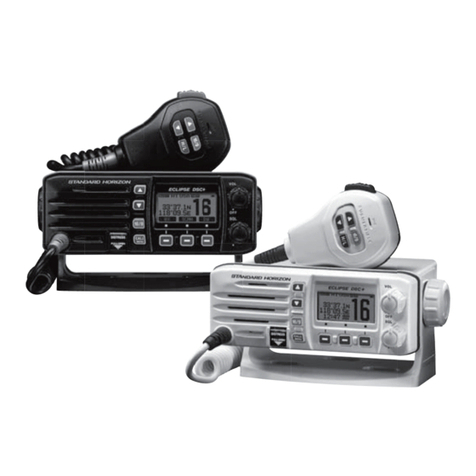
Standard Horizon
Standard Horizon Eclipse DSC+ GX1200 owner's manual
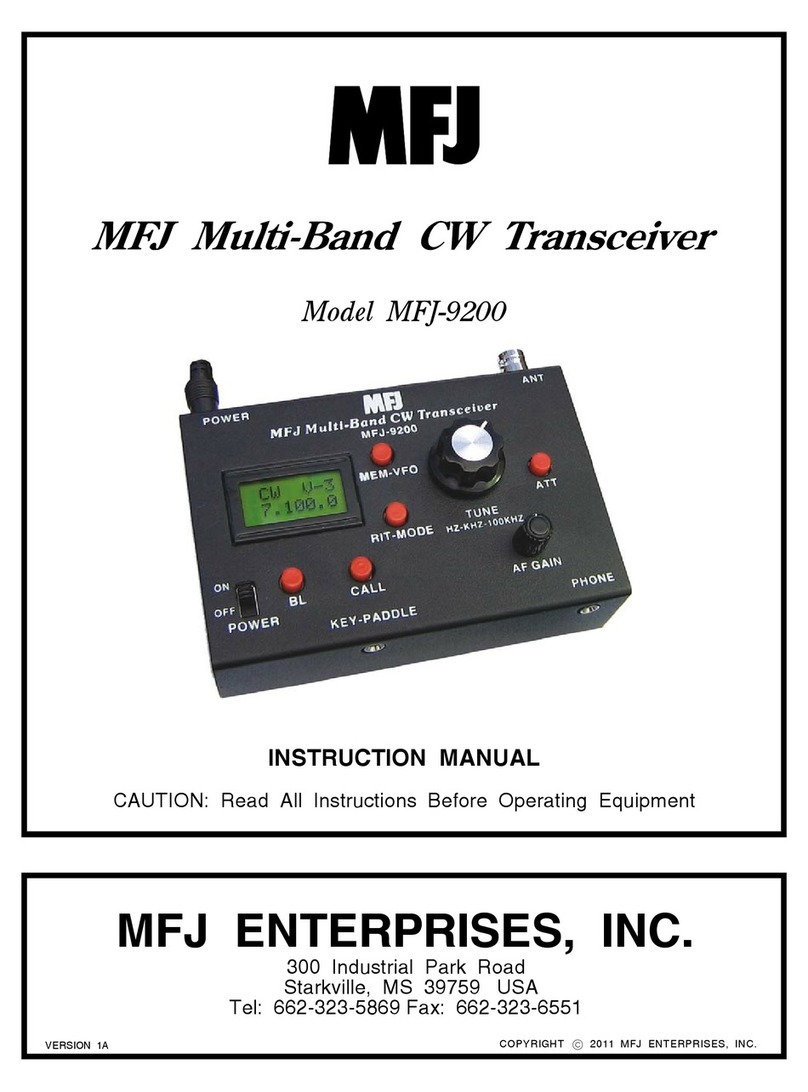
MFJ
MFJ MFJ-9200 instruction manual

Expert Electronics
Expert Electronics SunSDR2 DX quick start guide
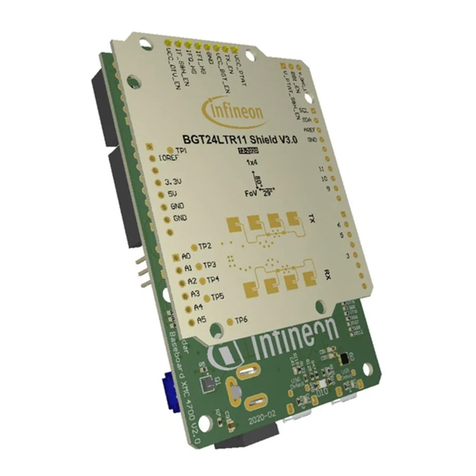
Infineon
Infineon BGT24LTR11 manual
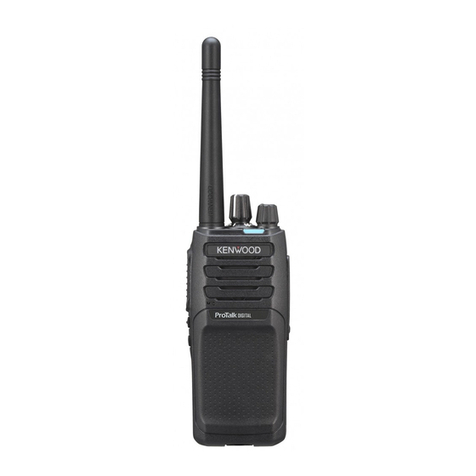
Kenwood
Kenwood ProTalk DIGITAL NX-P1200NV user manual
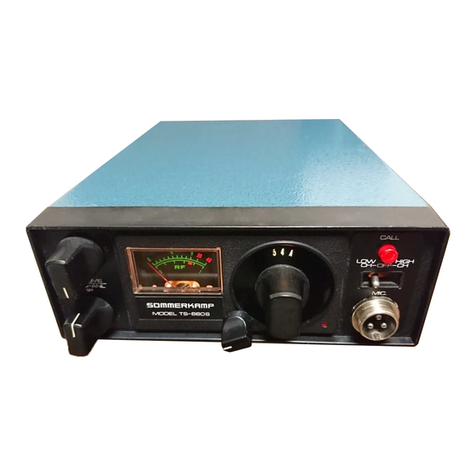
Sommerkamp
Sommerkamp TS-660S instruction manual

